- Home
- News & Events
- Wellness Features
Wellness Features
Wellness Features cover timely and pertinent college health and wellness topics in an effort to keep you informed on how to better your overall well-being. Features focus on a specific wellness topic or are connected to awareness weeks/months and highlight resources and new programs and events taking place on or around campus.
Features typically come out twice a month, so be sure to check back to see what is being covered! Stay notified of new features through the Paw Print and by following HPaW on social media @nuHPaW via Facebook, Instagram, and Twitter.
Back To School Wellness Tips
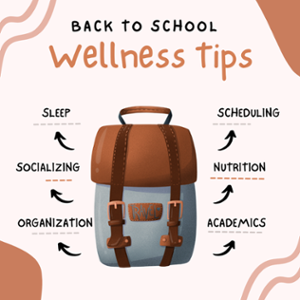 With new students arriving on campus, we are days away from the start of classes! We know you are still in the summer mindset where you are not on your school sleeping schedule and are probably making up hours of sleep during what would be a 9 a.m. class. As you probably know, it is not the best sleep schedule for a successful return to school. So, what do you do to get back into the school mindset? If you’re not sure where to start, let’s look at ways to get you back into a healthy school routine!
With new students arriving on campus, we are days away from the start of classes! We know you are still in the summer mindset where you are not on your school sleeping schedule and are probably making up hours of sleep during what would be a 9 a.m. class. As you probably know, it is not the best sleep schedule for a successful return to school. So, what do you do to get back into the school mindset? If you’re not sure where to start, let’s look at ways to get you back into a healthy school routine!
Create Your Morning Routine
Creating a morning routine can be essential to setting yourself up for success quarter to quarter and even for the whole year. Everyone’s morning routine is going to look different based on their unique schedule and needs. Here are some general ideas to add to your routine.
- Make sure you dress for the weather: Check the forecast the night before and lay out your clothes ahead of time.
- Do some prep before even going to bed: Make sure your lunch is prepared or decide where you are going to have your meals if you will be on campus.
- Gather all your necessary supplies for the next day.
- Write out your schedule for that day and make your to-do list.
- Consistency is key: Don’t stray from the same sleep and wake time including weekends. Set an alarm for the same time every day. You can use a smart alarm which helps to wake you up around the same time through the Sleep Cycle app.
- Start your day by fueling your body with a nutritious breakfast. Learn how to build a healthy breakfast here.
Create Your Bedtime Routine
Practicing a bedtime routine can allow you to get a good night’s rest, which sets you up for success the next day. This is the time for your body to recharge. Just like setting your morning routine, these will look different for each person. A bedtime routine can include things as simple as brushing your teeth, taking a shower or bath, and reading a chapter in a book for pleasure. This is supposed to be a relaxing time that helps you to transition from all your daytime activities to the time to fall asleep. Following this routine daily is essential to allowing your body to adjust so that every night around the same time, your body and mind know that it is time to log off and go to sleep.
Maybe you’re not getting the full 7-9 hours of sleep every night that you need to feel rested, or maybe the quality of sleep is not where you want it to be. A bedtime routine might be the thing that gets you right back on track. Here are some tips to create a healthy bedtime routine:
- Give yourself time to decompress from your day. Try meditation or journaling if you need to get thoughts off your mind.
- Don't wind down with your gadgets. Put your computer and phone to bed too!
- Relax with a cup of herbal tea or eat a light, pre-bedtime snack (if you're hungry). Just be sure to avoid spicy, fatty, and acidic foods, as well as caffeine, and alcohol.
- Take a warm bath or shower one to two hours before bedtime.
- Don't get into bed until right before it's time to sleep.
- Go to bed at the same time every night. As we said before, consistency is key!
Need help thinking through a bedtime routine to improve your sleep? Northwestern’s Health Promotion and Wellness department offers wellness coaching where you meet with a wellness coach to talk through goals to improve overall well-being, including improving sleep.
Healthy Meal Planning for the School Year
During the school year, it can be hard to find time to do something as simple as eating. So, what are ways you can go about addressing that? If you have the time and ability, you could find time each week to meal prep. For example, you could do it every Sunday before the school week. If you need help accessing groceries for meal prep, check out Northwestern’s Purple Pantry.
If you just don’t have the time in the week to prep meals, then plan time during your day to grab some lunch from the food court in Norris or go to a nearby restaurant on Sherman Ave. If you have a meal plan to access food, make time to go to the dining hall to get food. Fueling your body is vital to being successful every single day.
In fact, all these different options boil down to time management. Make the time to get your food whether it means putting it on your calendar or going in between classes. Feeding you will allow you to show up as your best self.
Keep Up with Your Overall Wellness
Get your recommended vaccinations. Staying healthy is essential to showing up as your best self every single day. Make sure to get your flu vaccine every year during flu session. Here are important tips to keep healthy during flu season, but these are good to just follow all year round.
- Wash hands regularly and often.
- Avoid touching your eyes, nose, or mouth with unwashed hands.
- Cover coughs and sneezes.
- Avoid close contact with people who are sick.
- Stay home when sick and until you’re fever-free for 24 hours without using fever-reducing medication.
- Clean and disinfect surfaces that may be contaminated with germs.
It is also good to make sure you know where you can go to get help in case of an emergency or if you need to see a doctor due to an illness. You can do that by calling your insurance customer service line to see what places are in their network and are covered under your insurance. If you don’t have insurance, you can investigate places that provide affordable health care or even through the Student Health Service
Start Building Your Calendar for the Fall Quarter
As the school year is quickly getting started, it is important to keep organized with your schedule, so you are as productive as possible. Get a planner or use your Google calendar attached to your Northwestern email to keep organized. What should you put on your calendar? First, start off by inputting all your classes. Following that, put all your extra-curricular activities like band, sports practice, or theater. Finally, you can put in valuable time like doctors’ appointments, dentist appointments, and study time. Having all this information on an organized calendar is a quick way to start the year off successfully. As you begin to get assignments, that is also a good addition to add to your calendar if it will not overwhelm you.
For some people, a crowded calendar can cause anxiety. So, make sure your calendar is tailored to what you can handle and what works best for you. If you are looking for a resource to help you create a schedule, watch The Unschedule Video.
Get to Know Some of Your Classmates
As you start classes, it is important to get to know your classmates. You will have exams and projects that you will need to lean on each other for and will have plenty of opportunities for study groups. Those built-in relationships can help you be most successful, especially in challenging classes. Outside of academics, college is a time when you make lifelong friends. Your next best friend might just be sitting in your Psych 101 class!
Additional Resources
'Cause We Like to Party: Tips to Reduce Harm When Drinking
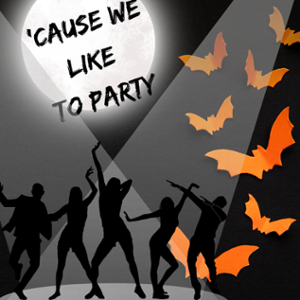 Here we are, halfway through the fall quarter and the weather is still reasonably nice, even though we can feel the cold temps and long nights approaching. But let’s put those thoughts in the back of our minds for a little longer and focus more on the fun stuff. The early weeks of the school year often mean parties and a time to be social. You may be meeting new people or reconnecting with friends you haven’t seen since leaving campus for the summer. For some, you are still feeling out the new vibes of being on campus and away from home. Exploring and expanding your social life in college is a key component to fostering your overall well-being. Being more social in college may also mean drinking alcohol, and for many, drinking alcohol for the first time.
Here we are, halfway through the fall quarter and the weather is still reasonably nice, even though we can feel the cold temps and long nights approaching. But let’s put those thoughts in the back of our minds for a little longer and focus more on the fun stuff. The early weeks of the school year often mean parties and a time to be social. You may be meeting new people or reconnecting with friends you haven’t seen since leaving campus for the summer. For some, you are still feeling out the new vibes of being on campus and away from home. Exploring and expanding your social life in college is a key component to fostering your overall well-being. Being more social in college may also mean drinking alcohol, and for many, drinking alcohol for the first time.
Now of course, the legal drinking age is 21+, but you may find yourself in settings where alcohol is available for anyone to drink regardless of their age. Some may choose not to engage in drinking and that is also okay! Nearly half of incoming first-year students report not drinking alcohol and 1 in 5 of all NU undergraduate students report not drinking alcohol. That choice is and always should be up to you, the individual. However, you may also make the choice to drink at an event. So, before you make that call, let’s make sure you are educated, know the risks involved, and know how to keep yourself (and others) safe.
Terms You Should Know
- Drinking in Moderation: 1 drink or less a day for females*; 2 drinks or less a day for males*
- Lower-Risk Drinking: no more than 3 drinks for a female or 4 drinks for a male on an occasion
- High-Risk (binge) Drinking: 4 or more drinks for a female or 5 or more drinks for a male on an occasion
- Problematic Drinking: 8 or more drinks for a female or 10 or more drinks for a male on an occasion
- Blood Alcohol Concentration (BAC) – A measure of the amount of alcohol in your bloodstream. Factors affecting your BAC include your sex assigned at birth, weight, how much you drank and how quickly you drank it.
* The terms “male” and “female” are used due to the way alcohol affects the sexes differently on a biological basis. Research is too limited to provide specific guidance for transgender and intersex individuals at this time.
Risk and Impairment Levels
Now that you have those definitions locked in, let’s talk about some risks associated with drinking. As you’ve just learned, there are lower-risk levels of drinking that can reduce the likelihood of experiencing a negative outcome. However, understand that there is no risk-free level of alcohol consumption, and the more you drink and faster you drink, the greater the likelihood becomes of experiencing negative effects. When your BAC gets too high, you risk serious injury, alcohol overdose**, and even death.
There are three zones that are used to describe the progressive effects of alcohol. The three zones are the social zone, the risky zone and the danger zone. The Social zone has a BAC level between 0.0-0.06, the risky zone BAC levels are between 0.07-0.20 and the danger zone has BAC levels between 0.21-0.40+. The more you can remain in the ‘social zone’ the less likely it is you will experience negative outcomes from drinking.
Curious what your BAC is after a night out of drinking? Try out our BAC estimator.
**What is an alcohol overdose? An alcohol overdose happens when a person has so much alcohol in their bloodstream that the areas of the brain that control basic life support functions begin to shut down. Signs of an alcohol overdose may include vomiting while unconscious, slowed or irregular breathing, cold and sweaty/clammy skin, loss of gag reflex, mental confusion, stupor and more. If you see someone who has any one of these symptoms, call 911 or get medical assistance immediately. If treatment is not received soon enough, it can put that person at risk of a coma or death.
BORGs?
“Blackout Rage Gallons”, or BORGs, are trending on college campuses. Whether it’s going to a concert or a party, BORGs seem to be the center of attention. They have even become a TikTok trend. We’re sure you’ve seen them – videos of people making BORGs and giving them creative names. (“Ruth Bader Ginsborg”, anybody?) Maybe you’ve seen them here around campus. And maybe, as you’re gearing up for your next party, you’re thinking about making one yourself. They don’t seem too bad from what you’ve heard, right?
BORGs are made by pouring out some of the liquid from a gallon jug or water and then pouring in liquor – often as much as a fifth (750 ml) of vodka, whiskey, or rum—along with some kind of flavoring, sometimes containing electrolytes. BORGs have also been promoted as “safer” because you can keep them just for yourself and closed with a cap to prevent anyone from putting something else in your drink. While that may be true, it requires you to never share your BORG, leave it unattended at any time, and essentially carry the large container with you at all times. How realistic does that sound if the intent is to keep a gallon-sized BORG with you for the entirety of an event?
Many BORG recipes encourage you to add the equivalent of 16 shots worth of liquor to your BORG. For most people, 16 shots will raise your BAC to dangerous or even deadly levels (.20 and higher) even if consumed over a full day.
Harm Reduction Tips
As a reminder, there is no risk-free level of drinking, but if you choose to drink, there are a few things you can do to reduce risk:
- Pace yourself and set a lower limit: A general rule of thumb is to pace drinks to one per hour and not consume more than the lower-risk limits of 3 or 4 drinks for females and males* respectively. Remember that even spacing out large quantities of alcohol (such as a BORG) raises a person’s BAC to dangerous levels.
- Drink water before, during, and after: Whether you are taking part in a BORG for the day or any other alcoholic beverages, be sure to consume water or other nonalcoholic beverages regularly to remain hydrated. This isn’t going to “kill your buzz,” but it will reduce the risk of becoming dehydrated, hungover, or worse.
- Know the levels of impairment, signs of intoxication, and how to help: Whether you or your friends have chosen to drink BORGs, knowing the signs and symptoms associated with alcohol overdose can help indicate when it is time to stop drinking or help a friend who has consumed too much alcohol. To prevent this from happening in the first place, set lower limits, pace yourself, drink plenty of water, and stick close to your trusted friends at any event where alcohol is present. If at any time there is concern that somebody is suffering from an alcohol overdose, call for help so that you are covered under the Amnesty through Responsible Action policy.
Additional Resources
Staying Well While Traveling
 One thing that we all look forward to during the summer is taking time away from our usual obligations and going on vacation. Vacations can be about finding time to tune out and recharge, or they can be about exploring unfamiliar places and learning new things. Vacations look different for everyone and that is okay. Regardless of why you are going on a trip, these times are typically super exciting and filled with a variety of plans. You do not want to miss the experiences so it is important that you stay as healthy as you can. Let’s discuss five important tips for staying well while traveling this summer and making your vacation everything you want it to be.
One thing that we all look forward to during the summer is taking time away from our usual obligations and going on vacation. Vacations can be about finding time to tune out and recharge, or they can be about exploring unfamiliar places and learning new things. Vacations look different for everyone and that is okay. Regardless of why you are going on a trip, these times are typically super exciting and filled with a variety of plans. You do not want to miss the experiences so it is important that you stay as healthy as you can. Let’s discuss five important tips for staying well while traveling this summer and making your vacation everything you want it to be.
- Change your voicemail and set an away message on your personal phone and school/work email. You do not want your vacation to be filled with never-ending calls, slack messages, and texts. Traveling and going on vacation is about taking your well-deserved off time. You may even consider deleting or pausing social media accounts. Also know that by doing this, you are not dismissing anyone or shutting them out. Rather, you are allowing yourself to create space and time for you – and those you are with – and asking others to respect that space as well.
- Don’t be afraid to say NO. There is that never-ending pressure to do as much as you can during a vacation. Honestly, that sounds overwhelming. If you end up spending most of the time you are on vacation just checking off one thing after another on your “to-do” list, you may not feel rested or satisfied at the end of it. It is okay to go on vacation, lie on the beach or at the pool and simply be. If you do enjoy being more active, try planning just 1 or 2 things to do each day to allow for a little more relaxation time. You may even end up being free to do something you did not even know was a possibility!
- Practice Mindfulness. Take some time each day and just pause allowing yourself to be present in the moment. Smell the air and listen to the sounds around you. If you find a dish that tastes amazing, just savor the flavors coming from the food. Allow yourself to feel all those thoughts and sensations that come over you. Take that extra moment to just enjoy where you are at.
- Catch your Z’s! Take some time to make sure your sleep is as good as it can be over vacation. One of the wonderful things about being on vacation is that you don’t have to hop up super early in the morning. You can sleep in! You can also stay up at all times of the night doing whatever you want to do. It is vital to make sure you are still getting proper sleep during this time. Taking naps in between activities can help allow your body to be well rested and serve you the way it is supposed to.
- Drink plenty of water! No matter what you are doing, it is essential to make sure that you are staying hydrated. Being outside of your normal routine when on vacation can make it easier for you to not drink the normal amount of water your body needs. You may also be tempted to consume alcoholic beverages in general or more than you normally would. Just because you’re on vacation, it doesn’t mean you should not follow low-risk guidelines to prevent things like hangovers or worse. Learn about the area you are traveling to to ensure that the tap water is safe to drink, otherwise be prepared to only drink purified/bottled water to prevent illnesses.
Use your vacation to kick your feet up and relax. You deserve this time to be able to do what you want, where you want. Set yourself up to have fun, relax and stay well during your time away so that you are ready to tackle whatever is waiting for you back home.
Additional Resources
BORG Around and Find Out... What You Really Need to Know About BORGs
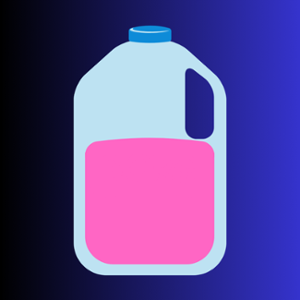 “Blackout Rage Gallons”, or BORGs, are trending on college campuses all around the country. Whether it’s going to a concert or a party, BORGs seem to be the center of attention. They have even become a Tik Tok trend. We’re sure you’ve seen them – videos of people creating BORGs and giving them creative names. (“Ruth Bader Ginsborg”, anybody?) Maybe you’ve seen them here around campus. And maybe, as you’re gearing up for spring, you’re thinking about making one yourself. They don’t seem too bad from what you’ve heard, right? Before you make that call, make sure you have the full story, know the risks, and know how to keep yourself safe.
“Blackout Rage Gallons”, or BORGs, are trending on college campuses all around the country. Whether it’s going to a concert or a party, BORGs seem to be the center of attention. They have even become a Tik Tok trend. We’re sure you’ve seen them – videos of people creating BORGs and giving them creative names. (“Ruth Bader Ginsborg”, anybody?) Maybe you’ve seen them here around campus. And maybe, as you’re gearing up for spring, you’re thinking about making one yourself. They don’t seem too bad from what you’ve heard, right? Before you make that call, make sure you have the full story, know the risks, and know how to keep yourself safe.
What Are BORGs?
BORGs are made by pouring out some of the liquid from a gallon jug and then pouring in liquor – often as much as a fifth (750 ml) of vodka, whiskey, or rum—and some kind of flavoring, sometimes with electrolytes. You may have heard that BORGs are essentially a hack to drink a bunch, have a wild night, and not feel terrible about it the next day. You might have even heard that they are safer because the alcohol is mixed with water and electrolytes, and you can keep them closed with a cap. Unfortunately, that isn’t the case.
Did you know?
A fifth of 80-proof liquor/40% ABV, which is what most Tik Tok recipes encourage you to add, is equal to 16 shots. No matter what else you mix into the jug or how much you try to water it down, you’re still drinking 16 shots. Diluting the alcohol with some sort of juice or flavoring may help mask the taste of the alcohol, but it doesn’t change how much you’re drinking, so it can be easy to think you’re not drinking as much alcohol as you really are. Not tasting the alcohol because of the juice or other flavoring can also make you drink it faster because you don’t realize how strong the BORG is. Ultimately, BORGs make it easy to drink too much alcohol without even realizing it.
Terms You Should Know
There can be some serious risks associated with drinking too much. But before we jump into that, let’s review some important definitions.
- Drinking in Moderation: 1 drink or less a day for females; 2 drinks or less a day for males
- Lower-Risk Drinking: no more than 3 drinks for a female or 4 drinks for a male on an occasion
- High-Risk (binge) Drinking: 4 or more drinks for a female or 5 or more drinks for a male on an occasion
- Problematic Drinking: 8 or more drinks for a female or 10 or more drinks for a male on an occasion
- Blood Alcohol Concentration (BAC) – A measure of the amount of alcohol in your bloodstream. Factors affecting your BAC include your sex assigned at birth, weight, how much you drank and how quickly you drank it.
* The terms “male” and “female” are used due to the way alcohol affects the sexes differently on a biological basis. Research is too limited to provide specific guidance for transgender and intersex individuals at this time.
Risks of BORGs
Now that we have those definitions locked in, let’s talk about some risks associated with drinking. There is no risk-free level of alcohol consumption, but the more you drink and the faster you drink, the more likely you are to experience negative effects as your BAC increases. If your BAC gets too high, you risk injury, alcohol overdose**, or death. As we mentioned before, many BORG recipes encourage you to add the equivalent of 16 shots worth of liquor to your BORG. For most people, 16 shots will raise your BAC to dangerous or even deadly levels (.20 and higher) even if consumed over a full day. The risk increases if you drink it over a shorter period. Curious how one BORG with the equivalent of 16 shots would affect your own BAC? Try out our BAC estimator, and check out the progressive effects chart below. 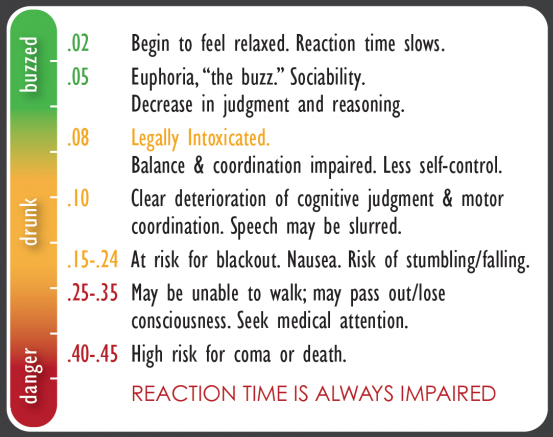
BORGs have also been promoted as “safer” because you can keep them just for yourself and closed with a cap to prevent anyone from putting something else in your drink. While that may be true, it requires you to never share your BORG, leave it unattended at any time, and essentially carry the large container with you at all times. How realistic does that sound if the intent is to keep a gallon-sized BORG with you for the entire day?
**What is an alcohol overdose? An alcohol overdose happens when a person has so much alcohol in their bloodstream that the areas of the brain that control basic life support functions begin to shut down. Signs of an alcohol overdose may include vomiting while unconscious, slowed or irregular breathing, cold and sweaty/clammy skin, loss of gag reflex, mental confusion, stupor and more. If you see someone who has any one of these symptoms, call 911 or get medical assistance immediately. If treatment is not received soon enough, it can put that person at risk of a coma or death.
Harm Reduction Tips
As a reminder, there is no risk-free level of drinking, but if you choose to use a BORG, there are a few things you can do to reduce risk:
- Make your own BORG with less alcohol: If you do choose to use a BORG, making your own gives you control over how much alcohol you add. Now that you know the risks of adding a full fifth, you can choose to add LESS alcohol. No one will know if you only put one or two shots or even no alcohol in your BORG. Keep in mind the lower-risk drinking guidelines and use the BAC estimator to make an informed decision.
- Use a smaller container: Just because the name implies using a gallon jug doesn’t mean you can’t go with something more manageable like a half-gallon or liter-sized bottle of water. This allows you to easily put less alcohol into the container from the start and still have a large amount of water. It’s also less cumbersome and easier to keep with you until you’re done.
- Pace yourself and set a lower limit: A general rule of thumb is to pace drinks to one per hour and not consume more than the lower-risk limits of 3 or 4 drinks for females and males* respectively. Remember that even spacing out large quantities of alcohol often associated with BORGs will raise a person’s BAC to dangerous levels.
- Drink water before, during, and after: Whether you are taking part in a BORG for the day or any other alcoholic beverages, be sure to consume regular water or other nonalcoholic beverages to remain hydrated. This isn’t going to “kill your buzz,” but it will reduce the risk of becoming dehydrated, hungover, or worse.
- Know the levels of impairment, signs of intoxication, and how to help: Whether you or your friends have chosen to drink BORGs, knowing the signs and symptoms associated with alcohol overdose can help indicate when it is time to stop drinking or help a friend who has consumed too much alcohol. To prevent this from happening in the first place, set lower limits, pace yourself, drink plenty of water, and stick close to your trusted friends at any event where alcohol is present. If at any time there is concern that somebody is suffering from an alcohol overdose, call for help so that you are covered under the Amnesty through Responsible Action policy.
Resources
BAC Estimator: Blood alcohol concentration (BAC) is a measure of alcohol in the bloodstream. If you choose to drink, we recommend gradually reaching a BAC of no more than .06%. Staying within this range helps to reduce the chance of experiencing negative outcomes associated with alcohol consumption. A BAC estimator can help you approximate how many standard drinks it takes to reach and maintain a BAC of .06%.
AOD Website: The Alcohol and Other Drug Resources website provides Northwestern students, parents, faculty, staff, and neighbors with a centralized hub for information, policies, programs, and services related to alcohol and other drugs. It represents the work of numerous campus partners who share the goal of supporting students in making responsible decisions about alcohol and other drugs, including low-risk use and non-use, to keep the Northwestern community safer and healthier.
BASICS, or Brief Alcohol Screening and Intervention for College Students, is designed for college students who drink/use drugs and are at risk for or have experienced negative consequences as a result of their use (e.g., injuries, blackouts, fights, physical or sexual assault, poor academic performance, legal problems). The goal of BASICS is to reduce the negative consequences of substance use by helping students make better substance use decisions.
eCheckUp To Go: The Alcohol eCheckUp To Go and the Cannabis eCheckUp To Go are interactive web surveys that allow students to enter information about their drinking or drug use patterns and receive personalized feedback about their use. The assessments take about 15 minutes to complete and require no face-to-face time with a counselor or health care professional.
Red Watch Band bystander intervention training: Red Watch Band provides Northwestern students with the knowledge and skills necessary to identify and intervene in an alcohol-related medical emergency. Participants learn how alcohol affects our physiology and behavior, the signs and symptoms of alcohol poisoning, how to prevent and/or respond to an alcohol emergency, and the truth behind common alcohol-related myths. Register here to attend a training this spring. Dates will continue to be added throughout the quarter.
The Value of Maintaining Quality Sleep
It may often feel like college is a time when there is so much going on that to gain the full experience and engage in all your interests means missing out on something else. The unfortunate reality is that sleep often becomes the activity that gets cut back on and not prioritized. Data collected from the 2019 NCHA-II survey shows that only 3 out of every 10 Northwestern undergraduates get enough sleep to feel rested five or more days a week. Nearly half (48%) of all Northwestern undergraduates indicate sleepiness as being 'more than a little problem' which is higher than the National Average (46%). 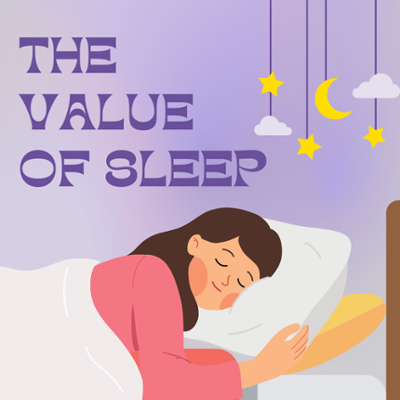
To neglect one’s sleep to instead study all night, stay out later for an event, or be a part of more organizations and activities could be causing significant health problems that in turn take away from those experiences or intended goals of performing better.
The adage “I'll sleep when I’m dead.” is often tossed around to justify putting off sleep so as not to miss out on something when you would otherwise be sleeping. The irony here is that by not prioritizing your sleep, you may in fact, be shortening your life. Recent research on regular restful sleep has shown that those who report meeting five key sleep metrics on average lived longer than those who did not. Good sleep habits not only provide immediate benefits to your wellbeing but are a long-term investment towards living a longer life.
Let’s explore sleep’s importance and impact on our health and well-being, circumstances that can disrupt sleep, and how to support your sleep through tools and support services.
The Importance of Sleep
Good sleep is a pillar of overall health and well-being. The Department of Health and Human Services good sleep helps support the following:
- Get sick less often
- Stay at a healthy weight
- Lower your risk for serious health problems, like diabetes and heart disease
- Reduce stress and improve your mood
- Think more clearly and do better in school and at work
- Get along better with people
- Make good decisions and avoid injuries — for example, drowsy drivers cause thousands of car accidents every year
Sleep studies have found that a key function for brain health that occurs during sleep is the removal of waste and toxins. This process, carried out by the glymphatic system, occurs during the deepest states of sleep which is why it is so important to be getting enough sleep each night to allow for this process to fully occur. Toxic proteins believed to contribute to conditions including Alzheimer’s and dementia are removed during this process.
Navigating Time Changes
While the debate of whether to do away with daylight saving time (DST) rolls on, we all must put up with changing the clock forward and essentially losing one hour. While this might not seem like a huge deal, it does in fact come with some significant health and wellness issues by disrupting your circadian rhythm. A detailed exploration of Daylight Saving Time and Your Health is provided by Northwestern Medicine.
Traveling can also cause sleep issues. This is commonly referred to as jetlag disorder, but there are ways in which to combat this as well. Learn more about jetlag disorder and how to prevent its effects from getting in the way of your trip or maintaining a healthy sleep schedule when returning home.
Cognition and Performance
One of the most important actions you can take to support learning and academic performance is to get enough sleep. As college students, prioritizing your sleep should be a top priority so that you can thrive in your academics and other activities. The article The Impact of Sleep on Learning and Memory, details numerous ways in how sleep plays a significant role in cognitive performance and in turn success as a student.
Support and Resources
Getting into a consistent pattern with your sleep schedule is an important component of overall health and well-being. Studies show that good sleep can add years to our lives
One way to begin improving your sleep is by improving your time management to ensure sleep is prioritized. If you think this is something you would benefit from, consider Wellness Coaching as way to explore your current behaviors and set goals to begin working towards a better schedule and improved sleep hygiene.
Talking to a therapist could be an excellent way to process things that are impacting your ability to fall and stay asleep. Perhaps there are feelings of FOMO at play or stress and anxiety making it hard to relax and fall asleep. If this sounds like something that might be affecting your ability to sleep well, consider speaking with a trained professional through CAPS or TimelyCare.
Finally, certain health conditions can impact a person’s ability to obtain good quality sleep. If you are or suspect that you are suffering from a condition that impacts your sleep, contact a healthcare provider to begin working on solutions to improving your sleep quality and overall well-being.
Additional Resources
Accessible Achievement: Wellness Resources That Won’t Break the Bank
In the thick of all the “new year, new me” resolutions being made, it can quickly feel as though you need to invest in all the new, fancy products and services in order to achieve the goals you set out for yourself. However, that new meal plan, fitness class, counseling service, etc. can all quickly rack up a large bill you weren’t prepared to take on, making your wellness goals seemingly inaccessible and an additional, unnecessary stressor in your life. The HPaW team is here to give you the inside scoop on some wallet-friendly ways in which you could achieve those wellness goals you set out for yourself early this year, with some even being on campus! Think of this list as HPaW’s thoughtfully curated, wallet-friendly resource playlist! It is by no means comprehensive, but a great starting point for creating a plan of action towards achieving your yearly wellness goals. 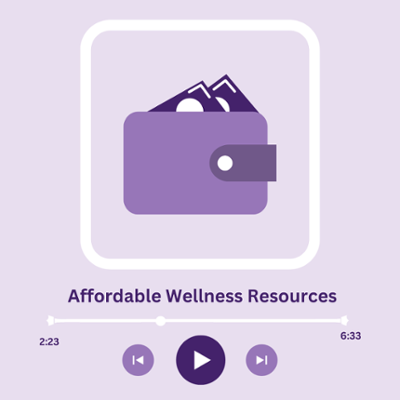
Accessible Food Options
Whether your goal is to have a more well-rounded diet, try new foods, or even simply ensure you make time to eat, these grocery store locations in the Evanston-Chicago area can offer great pantry staples, quick on-the-go meals, and organic produce options.
Aldi (2211 Oakton St, Evanston, IL 60202)
One of our personal favorite supermarket chains, Aldi does a great job at offering fresh and organic produce, consistent specials and markdowns on customer favorites, and even home goods. They offer curbside pickup if you ever are in a rush (as most Northwestern students are), as well as a partnership with Instacart, a grocery delivery and pick-up service for those who might not have access to a car.
Trader Joe’s (1211 Chicago Ave, Evanston, IL 60202)
Fun fact: Did you know that Aldi and Trader Joe’s are actually brother companies? The resemblance is uncanny once you take a closer look, with Trader Joe’s offering a wide assortment of frozen meals (perfect for those nights where you need to squeeze a quick meal in), tasty snack options, and even Trader Joe’s-branded pet supplies. Their website offers a variety of recipes with ingredients all found at their stores, making it a true one-stop shop. The cherry on top: A+ customer service and their trademark brown paper bags.
Purple Pantry (1835 Hinman Ave, Evanston, IL 60208)
Open weekly on Thursdays from 11:00am-2:00pm, the Student Enrichment Services (SES) Office offers Purple Pantry, their on-campus food pantry, to students facing food insecurity (unreliable access to sufficient quantity of nutritious food). The Purple Pantry is intended to be as barrier-free as possible, so it accommodates individuals with vegetarian, vegan, gluten-free, kosher, and halal dietary needs. Individuals experiencing difficulty accessing food should immediately contact the SES Office, as they are able to point to additional sources of support if needed.
Fitness and Physical Activity Resources
One of the more common areas in which people like to center wellness goals around is on their physical activity levels, whether it be through trying a new sport, prioritizing strength training, or simply showing up and trying. Some of the most accessible options to help achieve those goals can be found on our campus, including but not limited to:
Northwestern’s Group Fitness Classes (2311 Campus Dr, Evanston, IL 60208)
Northwestern University's Group Exercise Program has a long history of being at the forefront of the industry, based on the latest fitness trends and research findings, featuring experienced nationally certified instructors and a wide variety of classes for all fitness levels, abilities, and interests. Group Exercise classes are free for students and are offered on a first-come, first-served basis, with no required preregistration. Options include Zumba, HIIT, cycling, aqua fitness, yoga, and MORE, with all required equipment readily available to you on the day of class. All you really need to do is show up and try your best!
Norris Aquatics Center Open Swim (2311 Campus Dr, Evanston, IL 60208)
The Norris Aquatics Center pool is the center of many activities including practice and meets for the varsity swim and dive teams, NU sports clubs and age group and masters swim teams. A great option for those interested a more low-impact physical activity should check out their various open swim times throughout the week! Additionally, if you happen to not know how to swim, they also offer adult swim classes at a discounted rate for students!
Emotional and Mental Well-being Resources
Timely Care (Virtual)
As part of their ongoing efforts to offer the Northwestern community additional wellness resources, NU has partnered with TimelyMD, a leading provider of virtual health and well-being services for higher education, to offer Northwestern students free virtual mental health support through the TimelyCare platform. For more information of now you can use their services as a student, check out TimelyCare’s webpage on the Student Affair’s website
CAPS Gathering Spaces (Locations vary)
Northwestern Counseling and Psychological Services (CAPS) does a great job at offering ever-changing gathering spaces each quarter and this winter is no different! Workshops and gathering spaces are not therapy groups and they are not intended as a treatment for mental health concerns. Instead, these spaces focus on building resilience, cultivating authentic connection with others, and moving towards collective healing. Some great options right now are focused on cultural connection, with some options even being offered virtually! For information on the Winter 2023 programs and location information, check their CAPS Programming webpage
Using Your Health Insurance for Mental Health Care
Learning and taking advantage of the resources your health insurance automatically covers for you, even if outside of Northwestern, is a great way to be proactive towards protecting your overall health and wellbeing. Northwestern CAPS has a guide for how to go about exploring your health benefits on their websitemaking it easy for you to navigate this process on your own.
Drop-In Meditation (1870 Sheridan Road Evanston, IL 60208)
Meditation is traditionally practiced in a group setting with the guidance of a teacher. Join these weekly sessions to develop a new meditation habit, expand your current practice, and to connect with a community of contemplation on our campus. Each week will focus on a different approach to mindfulness practice (about 20 minutes total) with a short time for guided reflection and Q & A. No previous experience is necessary! Held weekly on Fridays during the academic quarter from 4:00pm-4:30pm in the Multi-Belief Space (Parkes Hall 204).
White Light Therapy (Wellness Suite-2311 Campus Dr, Evanston, IL 60208)
Unfortunately, with the cold winter months comes limited sun exposure and thus, depression, seasonal affective disorder (S.A.D), sleep disorders, and mood disorders. Located in the Wellness Suite, light therapy is offered free of charge to NU students as a way to combat these side effects and improve symptoms as early as a few days!
Wellness Resources: Staff Favorites
The HPaw team would like to share a few wellness resources/activities they do that are easily accessible to everyone, can be done in short periods of time, and help to nurture the mind and soul, which can easily be an area of focus for one’s new year’s resolutions!
Journaling via One Line a Day: A Five-Year Memory Book>
It’s easy to get lost in the heat of it all and forget to take time to express gratitude for the small things that make each day special and worthwhile. Taking less than 5 minutes to reflect on your day and choose something positive to share in this journal daily is a great pause button on the life of a busy Northwestern student. You can buy the actual 5-year long daily journal for about $15 on Amazon or simply pick your own journal to practice daily reflection!
Reading via Libby: The Library Reading App
As Arthur and friends said in that one episode, having fun isn’t hard when you’ve got a library card. The Libby app is a free virtual reading app, working with public libraries in the U.S. to provide a multitude of ebooks, audiobooks, magazines, cookbooks, etc. to those with a library card! Finding classic novels to NYT’s bestsellers to books recommended to you via “BookTok” has never been easier with Libby, especially since it works on almost any device, including your ereader. All you need to do is get an Evanston or Chicago Public Library card, connect it to your Libby account, and start reading for pleasure again!
With over 11 million subscribers, Adriene Mischler has mastered the art of connecting people through yoga with easy, beginner-friendly instructional videos, monthly yoga challenges, guided meditations, and more. Even better: it’s all free. Adriene does a great job not only hosting nourishing and revitalizing yoga sessions, but also is mindful about the variance in skill level her audience has, encouraging viewers to pause when needed, accommodate for comfort, and simply try their best.
Additional Resources:
New Year, New Me... Right?
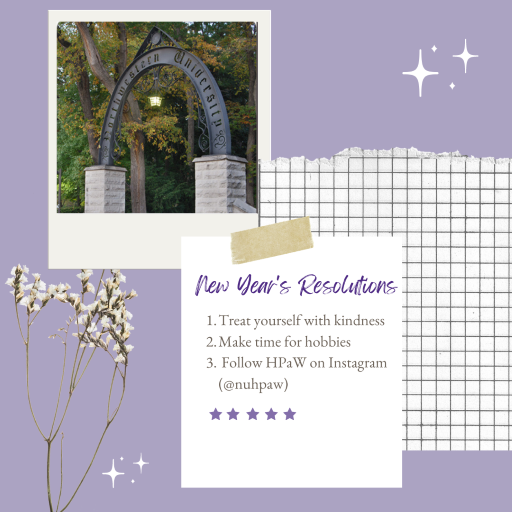 The start of the new year can inspire new beginnings and ambitious goal setting around one’s health and fitness, time management, self-care, and more. The HPaW team understands that handling the slower pace of the gloomy post-holiday hustle and bustle into this high-achieving season can get overwhelming, but we’re here to offer you some of our tried-and-true advice for how to sustain and maintain your new year’s resolutions!
The start of the new year can inspire new beginnings and ambitious goal setting around one’s health and fitness, time management, self-care, and more. The HPaW team understands that handling the slower pace of the gloomy post-holiday hustle and bustle into this high-achieving season can get overwhelming, but we’re here to offer you some of our tried-and-true advice for how to sustain and maintain your new year’s resolutions!
Picking the Right Resolution
The whole “new year, new me” idea might be good in theory, but in practice, it lends others to picking their new year’s resolutions for the wrong reasons, such as:
- Being based on what someone else (or society) is telling you to change.
- Being too vague.
- Not having a realistic plan for achieving said resolutions.
A framework the HPaW team uses when creating healthy and sustainable goals alongside students is SMART goals. The idea behind creating a SMART goal is that you are intentional with all the aspects and variables involved when working towards your goal, ensuring that it is sustainable and realistic for your lifestyle. The acronym itself, SMART, stands for:
- Specific: Your goal should be clear and demonstrate a direct pathway towards reaching that goal. Simply stating “I want to eat healthier” wouldn’t be as direct of a goal as it could be, making it easier to push aside and forget about.
- Measurable: Logging your progress, whether through photos, numbers of a scale, notes in a journal, etc. can reinforce the progress you are making and allow you to reflect on the relationship between your actions and time.
- Achievable: Having high hopes is a great source of motivation, so long as it is sustainable over time and throughout any lifestyle changes that may come up throughout your journey. Taking too big of a step too fast can leave one frustrated, so start off small and increase as needed.
- Relevant: At the end of the day, any goal you set for yourself should be something that truly matters to you and that is being set for the right reasons. Any progress you make with ill-intentions can be fleeting, so ensuring your goals are relevant to you and your lifestyle is important in maintaining them long-term.
- Time-bound: Like the achievable section, the timeline toward reaching your goal should be realistic and focused on long-term progress. Having too limited of a time frame can create unnecessary pressure or having too wide of a time frame can create too loose of a structure. Take it day by day and eventually, you’ll be looking back at months or years of strong progress towards your goals.
Understanding the Obstacles
As the saying goes, nobody’s perfect, and neither will the pathway towards reaching your goal be either. Life gets in the way, your mindset might change, or you might even find this journey to be overwhelming. We’re here to tell you that it’s natural and part of the process. The important thing, however, is knowing how to bounce back in a way that best fits your needs.
"I have so far to go towards reaching my goal": Looking at your current progress through a glass half-full approach can be that extra push necessary for you to complete your workout for the day or to get through a couple more chapters of your new book. Let this not convince you that you can’t ever look back at what you have left to go; it’s just a matter of how you frame it all.
"It’s hard to stay positive through it all": We get it; staying positive at all times can get kind of dull and unrealistic regarding what is going on. Maintaining that realistic lens throughout the positivity allows you to better understand how much further you must go, what obstacles you might encounter along the way, and allows you to plan accordingly.
"I already slipped up...": If you slip up, it's okay. It already happened and is bound to be part of the process. Focusing on the negative doesn’t help anybody, but rather just hurts yourself and your motivation. Each month, each week, or even each day is a new beginning, and you aren’t on anybody else’s clock but your own.
It could be a sign that you might want to dive deeper into where the process is breaking down. For example, if you’re interested in trying to quit smoking, you might learn that you enjoy smoking because of the calming effect it has on you. Replacing that habit with a healthier option like meditation or yoga offers the same effect but doesn’t let you slip up on your goal. This could be a way to finally move past the slip ups and maintain this habit.
Moving forward
Throughout this goal-setting journey, it is important to recognize that you are the one in control. If you want some time away from working towards your goals, that’s allowed. If you need support or accountability, that’s perfectly fine. If you want to change goals halfway through, more power to you! Be kind to yourself and give your grace, we’ll be here to cheer you on throughout!
Additional Resources
The Same but Different: What You Need to Know About the Updated 988 Suicide & Crisis Lifeline
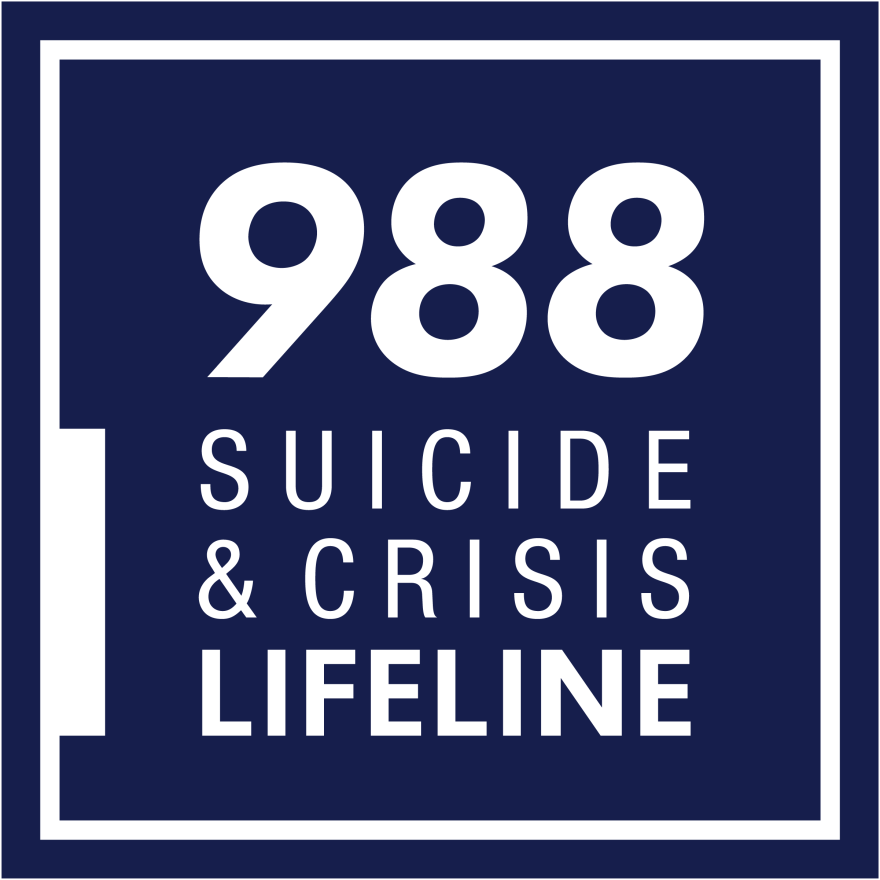
In 2020, Congress designated the new 988 dialing code to operate through the existing National Suicide Prevention Lifeline. After a two-year nationwide transition to expand access and the capabilities of 988, the Substance Abuse and Mental Health Services Administration (SAMHSA), along with the Federal Communications Commission and the Department of Veterans Affairs have made 988 a reality for individuals in need.
What is the 988 Suicide & Crisis Lifeline and How Can They Help?
Just like the original National Suicide Prevention Lifeline (“the Lifeline”), 988 provides free and confidential services from trained counselors 24/7, over the phone, via text, or through the Lifeline’s online chat feature. Counselors will listen, provide support, and connect individuals to necessary resources across the country and within all five U.S. territories.
The 988 dialing code will not replace the Lifeline 1-800 number (1-800-273-8255), but will strengthen and expand access to the network of crisis call centers already established. All calls made to either 988 or the original 10-digit number will be directed to the same service center, ensuring that anyone who is struggling with thoughts of suicide, a mental health or substance use crisis, or any other emotional distress can receive the support they need.
The Lifeline is currently offering calling services in English and Spanish and uses Language Line Solutions to provide translation services in over 250 additional languages. Unfortunately, text and chat services are only available in English, but SAMHSA is working to enable text and chat in Spanish and other languages as soon as possible. Lifeline is in the process of expanding to video phone service to better serve deaf or hard of hearing individuals, as well as serving TTY users through their preferred relay service or by dialing 711, followed by 1-800-273-8255.
Things to Note
Early debate surrounding the updated Lifeline urged that consumers be aware that using 988 may in some cases lead to involuntary detainment and/or hospitalization. Lifeline crisis counselors are required to call 911 if there is serious risk to life (as are other mental health professionals). The Lifeline states that less than two percent of calls require connection to emergency services like 911, and less than one percent of contacts require the crisis counselor to call 911 without consent. There is substantial data that supports what members of BIPOC and LGBTQ+ communities have been arguing for years—they are at greater risk of involuntary hospitalization. Stigma and the prohibitive cost of care also disproportionately impact BIPOC and LGBTQ+ communities.
In response, a growing number of communities, including Evanston, have established mental health crisis response teams. Non-profit Trilogy Behavioral Healthcare has partnered with local municipalities to offer the First-Response Alternative Crisis Team (FACT). If needed, FACT is dispatched in response to 988 calls in Evanston, Rogers Park, Skokie, and surrounding communities instead of police or other emergency services. According to the City of Evanston website, FACT “provides support to individuals in crisis when and where support is needed. Trilogy’s mobile crisis response team of mental health professionals will help you stay safe. In addition, they will create a safety plan and determine options for ongoing support.” The website also states that “988 provides easier access to the Lifeline network and related crisis resources, which are distinct from the public safety purposes of 911 (where the focus is on dispatching Emergency Medical Services, fire and police as needed.”
Confidential Resources for Northwestern Students
- Counseling & Psychological Services (CAPS) offers an array of services, including individual and group counseling, psychiatric services, referrals, and outreach and education. Evanston CAPS offers same day virtual appointments Students in crisis can call 847-491-2151 for a same-day crisis appointment. A crisis counselor is available in person on the Evanston campus during regular business hours (Monday-Friday 8:30-5). A counselor can be made available on the Chicago campus with advance notice. After hours, call 847-491-2151 and press “0” at the prompt to be connected to the CAPS emergency resource.
- Religious and Spiritual Life: The University Chaplains are available to talk confidentially with anyone who would benefit from a listening ear. You do not need to belong to a religious tradition to speak with a Chaplain. Click here to make an appointment or stop by the Chapel Office (Parkes Hall 139) during business hours to visit with a Chaplain.
- TimelyCare is a 24/7 free, confidential, virtual resource for Northwestern students. TimelyCare offers scheduled counseling and on-demand access to a mental health practitioner to talk about anything at any time.
- Center for Awareness, Response, & Education (CARE) is a confidential space for students impacted by sexual violence, relationship violence or stalking, including friends or partners of survivors. CARE staff are available Monday through Friday from 8:30 am - 5:00 pm by appointment. Click here to make an appointment. Note: Students in crisis should contact CAPS during business hours. Students in immediate physical danger should call 911. After hours, students can call CAPS at 847-491-2151 and press “0” at the prompt to be connected to the CAPS emergency resource, or contact TimelyCare.
Other Campus Resources
- Student Assistance and Support Services
- Medical Leave of Absence (MLOA)
You can also access mental health resources beyond campus like those listed below:
- National Alliance on Mental Illness
- Substance Abuse and Mental Health Services Administration
- National Institute of Mental Health
- The JED Foundation
- The Trevor Project
If you or someone you know is experiencing a mental health crisis or considering suicide, know that help is available. Calling 988 can save a life.
Financial Literacy as a Student

It is common to hear students bemoan that there is no adulting class in high school or college with a crash course on personal finance (though that is changing). Taxes, mortgages, credit scores, loans, and investments are daunting topics that might seem like pressing problems for a future version of yourself.
Anxiety here can come from growing up with money as a taboo subject. According to this March 2022 study, 31 percent of U.S. parents never talk to their children about household finances. That becomes a problem when those children face financial barriers later and lack the confidence and expertise to make informed decisions. It is even more so an issue for the 20 percent of Americans who do not feel like they have anyone they trust to question about finance.
All this is said not to scare you into befriending a Kellogg student to do your taxes or scrolling endlessly through financial TikTok. Instead, this article lists some digestible resources to start your ongoing journey of financial literacy. As you confront questions on the likes of budgeting for study abroad or negotiating the salary of your first job, there are folks at Northwestern ready to help!
Websites to Explore Personal Finance
- Northwestern Money 101: Get a refresher on the likes of banking and budgeting through this user-friendly student resource.
- CrashCourse: Northwestern partnered with the National Endowment for Financial Education to provide you with this free online program.
- U.S. News – Financial Literacy for College Students
- Mymoney.gov: This government resource discusses the principles to manage and grow your money.
- MoneySkill: This is a free personal finance course for high school and college students.
Videos to Learn those Finance Basics
- Money, Explained: Netflix has a multi-part series voiced by famous actors and comedians to explain the many complexities of spending, borrowing, and saving.
- PBS Making Cents – Financial Literacy Educational Videos
- Khan Academy Personal Finance
Financial Podcasts
- Investopedia’s top 10 personal finance podcasts
- 6 personal finance podcasts that won’t bore you to death
- 10 best personal finance podcasts of 2022
- 9 personal finance podcasts for students
Financial security is an important component of your overall wellness. Explore these resources and seek support when needed to best manage this aspect of your life!
Support Your Mental Health by Getting Outside!
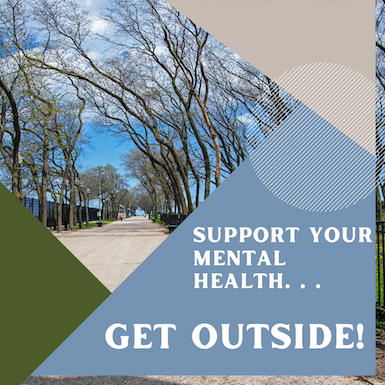 With Earth Day right around the corner and the gradual progression towards nicer weather, the HPaW team thought it would be an ideal time to highlight the incredible health benefits of spending time outside. We are not just talking about taking a lengthy hike or a weekend camping trip. 20 minutes a day spent along the lake or simply in your backyard has been repeatedly shown in research to be just as advantageous for one’s physical and mental health. Strolls outside became quite popular during pandemic lockdowns, and the following facts might convince you to maintain the routine even as indoor spaces become normal gathering spots again. A new habit would set you apart from the average U.S. resident who spends around 90 percent of their time indoors or in a vehicle. Allow this information to both inspire you and remind you to take care of our environment just as it is taking great care of us.
With Earth Day right around the corner and the gradual progression towards nicer weather, the HPaW team thought it would be an ideal time to highlight the incredible health benefits of spending time outside. We are not just talking about taking a lengthy hike or a weekend camping trip. 20 minutes a day spent along the lake or simply in your backyard has been repeatedly shown in research to be just as advantageous for one’s physical and mental health. Strolls outside became quite popular during pandemic lockdowns, and the following facts might convince you to maintain the routine even as indoor spaces become normal gathering spots again. A new habit would set you apart from the average U.S. resident who spends around 90 percent of their time indoors or in a vehicle. Allow this information to both inspire you and remind you to take care of our environment just as it is taking great care of us.
Physical Benefits of Time Outside
- Around 40% U.S. residents are deficient in Vitamin D, and time outside can help remedy this. Vitamin D is essential for bone growth and helps regulate the immune system.
- Outdoor spaces in urban areas have been shown to be more enticing for physical activity and tend to better motivate community members to exercise.
- Experiments comparing the ability to complete a strenuous task in different settings found that those participants in a natural, outdoor setting were more successful and able to focus.

Mental Benefits of Time Outside
- Experiencing nature can lower your cortisol levels and blood pressure, thereby lowering stress and fatigue.
- Time outside the home may increase social connectedness and interactions with the community.
- In a study following the effects of walking in a forest, this time spent outside was found to decrease hostility and depression and increase liveliness.
- Research highlighted by the Yale School of Environment found in a study of 20,000 people that those who spent two hours in a green space were significantly more likely to report good health and psychological well-being than those who did not partake in outdoor time.
With the empowering impacts of nature in mind, it is also important to recognize that many Chicagoans and other people across the country do not have easy access to safe, natural landscapes. Communities are not always in close proximity to welcoming and usable parks, and the outdoor industry does not highlight many populations in its marketing materials. It is challenging for those who never see themselves represented in the media partaking in outdoor activities to embrace natural environments. There are many incredible organizations such as Chicago Voyagers and BackYard Nature Center working to defy stereotypes and ensure everyone can enjoy the outdoors.
Some Fun Spots to Visit Nearby!
- Bahai Temple Gardens (20-30 min walk)
- Chicago Botanic Garden (20 min drive)
- Green Bay Trail (<1 mile west of campus)
- Indiana Dunes National Park (75 min drive)
- Starved Rock State Park (120 min drive)
- Right on campus!
- Evanston Beaches
- Forst Preserves of Cook County
Additional Resources
- US Forest Service Discussion of Wellness
- Colorado Wellness Symposium
- Health Matters: Benefits of Going Outside
- Psychological Effects of Forest Environments
- Yale School of Environment
Past Wellness Features
Accessibility at Northwestern and Beyond
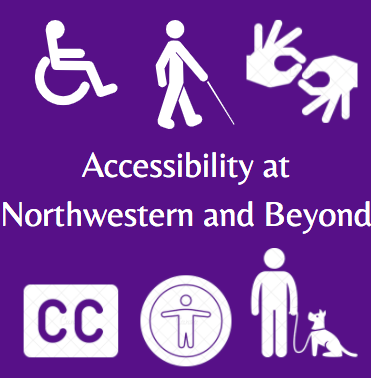
The Americans With Disabilities Act (ADA), signed in 1990, legally guarantees that people with disabilities have the same opportunities to participate in everyday activities as everyone else. To ensure that equal access exists on Northwestern’s campus, the AccessibleNU office supports students through the provision of accommodations from sign language interpreting to alternative testing arrangements. Regardless of if you use these resources directly, it is important to know what is available at the campus and city level to ensure that people with disabilities are being catered to. This will allow you to be a better ally and community member when creating materials, organizing events, or even just presenting in class. The sections below outline university resources and accommodations. These sections do not cover everything, so please refer to the AccessibleNU website or the ADA website among others for additional information. Keep in mind that not all disabilities are visible, and you are not entitled to know the personal information of anyone else.
Accessibility Across Campus
- Students who use mobility aids or cannot use the stairs can access this page to learn more about parking across campus and connect with someone about accessible routes
- The Office of Equity at Northwestern has a page to report an accessibility issue
- ANU provides an Accessible Event Guide and the office can help organizers estimate the cost of additional resources
- The Global Learning Office offers support in ensuring that accommodations can be made throughout the study abroad process
- The Northwestern library has a disabilities service section on their website that outlines the accessibility of various facilities and the accommodations that can be made
- Northwestern Information Technology lists the assistive technology the office provides, some of which can be accessed regardless of ability
- As you all know, the Evanston campus is large and so are individual buildings, so that’s something to keep in mind when planning a group meeting or an event
Accessibility in the Classroom
- The Office of Equity offers several resources to ensure that our new virtual or hybrid format is amendable to everyone. You can find best practices for Zoom or Canvas and training modules if you would like to become more well-versed in the topic
- Most schools and offices on campus have a designated Digital Accessibility Liaison dedicated to developing and implementing accessibility plans
Disability Language
As is the case with any other identity, individuals have different opinions when it comes to the correct language in referencing a disability. This page for ANU is just a start to understanding how to create a welcoming and respectful environment when speaking or writing. Northwestern has their own set of recommendations available under Brand Tools here. You can also check out this guide created by Stanford and another put together by University of Illinois at Urbana-Champaign.How to Engage Further
- There are various organizations on campus that cater to the disabled community and its allies
- The City of Chicago features the Mayor’s Office for People with Disabilities and has many programs and resources from trainings and emergency preparedness to youth employment services
- The OmsteadRights website lists Illinois disability resources and advocacy organizations
- WeThe15 is a global coalition of organizations aiming to highlight and create opportunities for people with disabilities
- Podcasts such as iWeigh, Equal Too, and any listed here are a great way to educate yourself on the disabled community and become a more informed ally
Additional Resources:
It's OK to Talk About Suicide
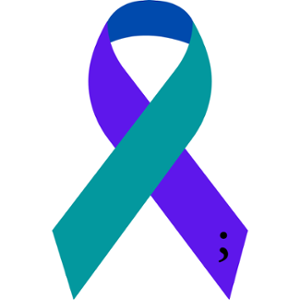 Annually, 11.8% of young adults aged 18 to 25 have serious thoughts of suicide. Suicide is the second-leading cause of death among college students which is a statistic that has yet to take into account the isolating effects of the pandemic. Around 54% of Americans report being affected by suicide because of the high rates.
Annually, 11.8% of young adults aged 18 to 25 have serious thoughts of suicide. Suicide is the second-leading cause of death among college students which is a statistic that has yet to take into account the isolating effects of the pandemic. Around 54% of Americans report being affected by suicide because of the high rates.
Though these figures are worrying, suicide is preventable. Oftentimes, individuals will exhibit behavior or make comments that indicate their contemplation of suicide. If we as a Northwestern community are attentive to our peers and aware of the resources available, we can ensure that our students, faculty, and staff can have a safe and supported return to campus. The transition back to on-campus activities and rigorous schedules is incredibly stressful. This time of change is the opportune moment to take care of yourself and the people around you.
In recognition of September as Suicide Prevention Awareness month, here are a few key resources offered by Northwestern and outside sources. You do not need to be a mental health professional to take advantage of these resources and make a profound difference in someone’s life.
This is not an exhaustive list, and there are plenty of resources that pertain to specific identities or scenarios. We encourage you to do your own research and ask questions if you are looking for something different than what you see below.
Direct Service
- Northwestern Counseling and Psychological Services (CAPS) has a crisis counselor available Monday through Friday from 8:30 am to 4:00 pm. When the office is closed, an on-call counselor is available at 847-491-2151 (press “0” at the prompt)
- The National Suicide Prevention Lifeline is 1-800-273-8255, this line offers a Spanish option
- The Crisis Text Line is available if you text HOME to 741741
- The Trevor Project supports LGBTQIA+ youth - their lifeline is 1-866-488-7386 or you can text START to 678-678
Training
- CAPS outlines several initial strategies to assist an individual considering suicide
- CAPS also offers QPR (Question-Persuade-Refer) Suicide Prevention Gatekeeper Training to any student, faculty, or staff member who would like to learn how to recognize the warning signs of suicide and act quickly to provide support
- Mental Health First Aid provides trainings across the country on how to help someone experiencing a mental health or substance-use related crisis
Advocacy
- Northwestern has a number of student-run organizations at the undergraduate level that focus on the mental health of the student body or the greater community
- The City of Evanston and NAMI Chicago sites list nonprofits and government organizations related to suicide prevention that accept donations or volunteers
Additional Resources
- The Suicide Prevention Resource Center provides a list of mental health resources to support coping with COVID-19
- The Jed Foundation is a leading nonprofit focused on preventing suicide for young adults
- You can find more resources on the CAPS page here
Additional Resources
- What You Can Do To Help (CAPS)
- Suicide Prevention Resource Center
- The JED Foundation
- National Alliance on Mental Illness
- National Institute of Mental Health
- Substance Abuse and Mental Health Services Administration
#MentalHealthAwareness | MIND, Body, and Spirit
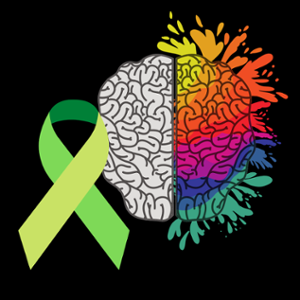 Your mental health is a pillar to your overall wellbeing and the past 14 months have tested many of us more than ever before. Prior to the pandemic though, more attention has been given to the need to support mental health. As we close out the month of May and the academic year, we want to focus on this critical component to wellbeing to help you better understand this area of wellness and connect with resources that can help both now and moving into your next chapter.
Your mental health is a pillar to your overall wellbeing and the past 14 months have tested many of us more than ever before. Prior to the pandemic though, more attention has been given to the need to support mental health. As we close out the month of May and the academic year, we want to focus on this critical component to wellbeing to help you better understand this area of wellness and connect with resources that can help both now and moving into your next chapter.
While 1 in 5 people will experience mental illness over the course of their lifetimes, everyone will face challenges that can affect their mental health. Yet nearly two-thirds of people with a known mental health illness never seek treatment. Recognizing your feelings, finding the routines that lift you up, removing toxic influences, and connecting with others can all help you on your path to recovery as you develop your own positive mental health strategies.
Northwestern has a multitude of services to support your emotional and mental wellbeing. From CAPS to RSL, from Wellness Coaching to BREATH, there is something to get you started in exploring your needs connected to mental wellness.
Beyond the University, countless organizations exist that can provide additional information and connect you to the best service to meet your needs. NAMI, SAMHSA, NIMH, and the JED Foundation are just a few not to mention instant support through the Suicide Prevention Lifeline 800-273-TALK and National Helpline 800-662-HELP.
Mental Health Resources
#AlcoholAwarenessMonth | Alcohol's Impact on Wellbeing and the New AOD Resources Website
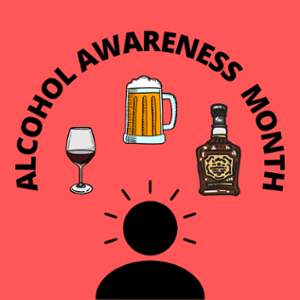 The month of April brings attention to many important health topics including autism, stress, STIs, and sexual assault. It is also Alcohol Awareness Month, a particularly important topic to engage in learning around for college populations. Alcohol use remains the number one misused substance among college-aged students and as a result, causes significant public health issues. An estimated 1,519 college students aged 18-24 lose their lives to alcohol-related injuries, including motor vehicle accidents, every year. But aside from the tragic loss of life that alcohol causes, numerous other negative outcomes are strongly associated with high-risk alcohol use among college students including physical assault (696,000), sexual assault (97,000), academic problems, developing alcohol use disorder, suicide attempts, health problems, injuries, unsafe sexual behavior, driving under the influence of alcohol, vandalism, and involvement with the police.
The month of April brings attention to many important health topics including autism, stress, STIs, and sexual assault. It is also Alcohol Awareness Month, a particularly important topic to engage in learning around for college populations. Alcohol use remains the number one misused substance among college-aged students and as a result, causes significant public health issues. An estimated 1,519 college students aged 18-24 lose their lives to alcohol-related injuries, including motor vehicle accidents, every year. But aside from the tragic loss of life that alcohol causes, numerous other negative outcomes are strongly associated with high-risk alcohol use among college students including physical assault (696,000), sexual assault (97,000), academic problems, developing alcohol use disorder, suicide attempts, health problems, injuries, unsafe sexual behavior, driving under the influence of alcohol, vandalism, and involvement with the police.
While some may wish that college students would simply choose to abstain from alcohol use, we acknowledge the existing alcohol culture and that abstinence from drinking may not be the goal for every college student. Therefore, we approach reducing these negative outcomes through a variety of proven harm reduction methods. As students, we invite you to engage with this topic through educational opportunities as a means to raising your awareness of what you and others can do to push back against misperceptions around use, continue with or shift to lower-risk drinking behaviors, and shape a campus environment where everyone feels safe and able to thrive regardless of their choice to consume alcohol.
We are excited to present the newly designed Alcohol and Other Drugs Resources website at this time. The AOD Resources website provides Northwestern students, parents, faculty, staff, and neighbors with a centralized hub for information, policies, programs, and services related to alcohol and other drugs. It represents the work of numerous campus partners who share the goal of supporting students in making responsible decisions about alcohol and other drugs, including choosing lower-risk use and choosing not to use, to keep the Northwestern community safer and healthier.
Finally, it is imperative to remember that we are still living through a global pandemic and substance use, not just alcohol, can increase risk of exposure to and impact one’s ability to fight off or recover from illnesses. For that reason, we have provided a concise page of information with ways in which to prevent alcohol or other substances from impacting your health and wellbeing during this time.
If you are seeking help in navigating your substance use, there are a number of services you can choose from. Simply navigate to our Support for Students page or contact Health Promotion and Wellness directly by emailing hpaw@northwestern.edu for help navigating next steps.
For additional information, follow HPaW on social media.
Alcohol Resources
#SAAM | Sexual Assault Awareness Month
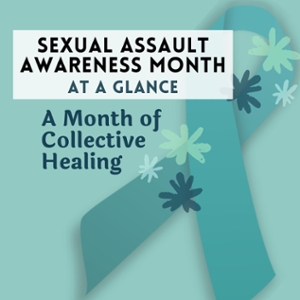 This month, the Center for Awareness, Response, and Education (CARE) is focusing SAAM on the broad theme of Collective Healing, with a different piece for each week of April. Collective healing is an approach that’s been used for generations to process and heal from trauma, specifically in Black and Indigenous communities healing from collective trauma. A considerable part of collective healing is acknowledgment of the trauma and understanding of the methods individuals & communities used to survive, and ultimately connecting to the community and the history that bonds and brings us together. Experiences of sexual violence, and more generally collective trauma, can benefit from a collective healing approach to recognize and interrupt its historical, cultural, and collective existence. Collective healing relies on the close relationship between the individual and the community - everyone experiences and heals from interpersonal violence differently, so individual healing is inherently tied to collective healing.
This month, the Center for Awareness, Response, and Education (CARE) is focusing SAAM on the broad theme of Collective Healing, with a different piece for each week of April. Collective healing is an approach that’s been used for generations to process and heal from trauma, specifically in Black and Indigenous communities healing from collective trauma. A considerable part of collective healing is acknowledgment of the trauma and understanding of the methods individuals & communities used to survive, and ultimately connecting to the community and the history that bonds and brings us together. Experiences of sexual violence, and more generally collective trauma, can benefit from a collective healing approach to recognize and interrupt its historical, cultural, and collective existence. Collective healing relies on the close relationship between the individual and the community - everyone experiences and heals from interpersonal violence differently, so individual healing is inherently tied to collective healing.We urge the Northwestern community to participate when able in this month's events and engage on social media as much as possible. Our hope for the month is to bring us together as a community, through support and solidarity, and begin to collectively move toward healing (however defined). We need your support!!
For additional information, follow CARE on Facebook, Instagram, and Twitter
#BrainInjuryAwareness | A Brain Injury Can Happen to Anyone
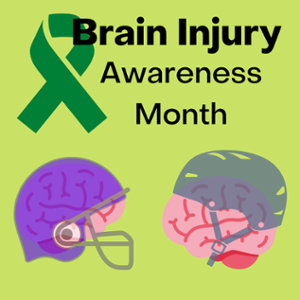 If you’re a fan of football, you most certainly have seen a player take a blow to the head that knocks them unconscious for a moment or has them unable to stand back up without appearing disoriented. This is one of the more common examples of a person sustaining a brain injury known as a concussion. However, concussions and brain injuries as a whole, are not relegated solely to the world of sports and can occur to anyone as a result from a multitude of factors.
If you’re a fan of football, you most certainly have seen a player take a blow to the head that knocks them unconscious for a moment or has them unable to stand back up without appearing disoriented. This is one of the more common examples of a person sustaining a brain injury known as a concussion. However, concussions and brain injuries as a whole, are not relegated solely to the world of sports and can occur to anyone as a result from a multitude of factors.
What is a Brain Injury?
As defined by the Brain Injury Alliance, “A brain injury is an injury to the brain that occurs after birth and is not congenital, degenerative or hereditary. The injury results in a change of the brain’s neuronal activity. There are two types of brain injury: Traumatic Brain Injury and Acquired Brain Injury.”
Traumatic Brain Injury (TBI): A TBI is caused by an external factor such as a bump, blow or jolt to the head that disrupts the normal function of the brain. TBI can be defined as closed (non-penetrating) or open (penetrating). The severity of a TBI may range from mild (for example, concussion) to severe.
Acquired Brain Injury (ABI): An ABI is an alteration in brain functioning or pathology caused by internal factors such as a lack of oxygen.
How is a person likely to sustain a brain injury?
A brain injury can result from numerous factors. Many brain injuries will occur from a single severe event where the head sustains a significant blow such as during a fall, car accident, or sports related injury resulting in a concussion. A brain injury can also develop over time due to conditions including a brain tumor, infectious disease, or neurotoxic poisoning.
Unfortunately, it is important to note that brain injuries can be the result of physical altercations including abusive relationships. If you or a friend are in an abusive relationship, seek help. Northwestern and the surrounding area have confidential support services to help should you find yourself in this situation.
How can you prevent/lessen the severity of a brain injury?
There are many simple ways in which you can prevent or lessen the severity of a brain injury from occurring.
WEAR A HELMET! It cannot be stressed enough that wearing a helmet during these activities significantly reduces the likelihood and severity of sustaining a head/brain injury:
- Ride a bike, motorcycle, snowmobile, scooter, or use an all-terrain vehicle
- Play a contact sport, such as football, ice hockey, or boxing
- Use in-line skates or ride a skateboard
- Bat and run bases in baseball or softball
- Ride a horse
- Ski or snowboard
PRACTICE SAFE DRIVING HABITS
Always Wear A Seatbelt. Whether you are the driver or a passenger, wearing a seat belt every time you are in a vehicle significantly decreases the chance of suffering an injury, not just head/brain injuries.
Do Not Drink And Drive. Even low levels of alcohol increase the risk of a car crash. If you plan to drink and need transportation use a sober designated driver or public transportation.
Avoid Distracted Driving Habits. Silence, enable the ‘do not disturb’ function, or put your phone away when driving; do not make phone calls or text while operating the vehicle. Do not read, eat, or groom while driving.
Keep Substance Use to Low-Risk Levels and Never Mix Substances. Falls are much more common when a person is intoxicated due to impaired coordination. Mixing substances, including OTC and prescription medications, can result in severe reactions leading to injury.
Make Living Areas Safer. Have you ever bumped your head on a low ceiling or other objects? This can commonly occur when beds are bunked or lofted. Avoid setting your living space this way if at all possible. Otherwise, place padding on any hard exposed surfaces that your head is likely to come in contact with. Ensure handrails are installed and secure on all staircases. Also, ensure any carpeting is secure or install stair tread covers for additional grip.
Signs & Symptoms of a Brain Injury
Brain injuries can cause an impairment of cognitive abilities or physical functioning and result in the disturbance of behavioral or emotional functioning. Many symptoms appear immediately after the injury while others can develop over the coming days or weeks.
Some common symptoms include:
- Headaches
- Difficulty concentrating
- Becoming easily confused
- Slowed thought processes
- Difficulty with memory
- Nausea
- Lack of energy, fatigue
- Dizziness, poor balance, lightheadedness
- Blurred vision
- Sensitivity to light and sound
- Poor sleep
- Mood changes (irritable, anxious, or sad)
What to do after sustaining an injury
The good news is, concussions and other brain injuries can be treated and symptoms can go away over time with proper care, which is why it is important to address any injury early on. In the event of a severe accident (the person is unconscious, bleeding, in severe pain, or immobile), call 911 for immediate help. If you are noticing any of the symptoms listed above after hitting your head, you should call the Health Service at 847.491.2204 as soon as possible to schedule an appointment. At your appointment, you will receive a comprehensive cognitive and physical assessment. Additional follow-up, referrals, and resources will be designated at your initial appointment.
A brain injury can make things like going to class, concentrating, and doing academic work more difficult. If class increases the severity of your symptoms, you should not attend. At your initial evaluation, you can fill out a release of information to inform the Dean of your school about your academic modifications. Your physician will work with you to help find adjustments during this time.
Avoid all physical activity while healing until you are cleared by your physician.
For additional educational information, contact Concussion Specialist, Brian Vesci, DAT, ATC, at vesci@northwestern.edu
Important Brain Injury Links:
Educational Concussion Video (Students)
Concussion Care (NUHS Sports Medicine)
#NationalNutritionMonth | One Size Doesn’t Fit All; Personalize Your Plate!
 National Nutrition Month® is an annual campaign created by the Academy of Nutrition and Dietetics. During the month of March, everyone is invited to learn about making informed food choices and developing healthy eating and physical activity habits. But learning about nutrition should not only take place during the month of March. With the amount of information that is available around this topic, we invite you to bookmark our Wellness Feature page so you can come back to this feature (and others) whenever you need to connect to this content again. We will also be sharing a variety of information through social media @nuHPaW on Facebook, Instagram, and Twitter!
National Nutrition Month® is an annual campaign created by the Academy of Nutrition and Dietetics. During the month of March, everyone is invited to learn about making informed food choices and developing healthy eating and physical activity habits. But learning about nutrition should not only take place during the month of March. With the amount of information that is available around this topic, we invite you to bookmark our Wellness Feature page so you can come back to this feature (and others) whenever you need to connect to this content again. We will also be sharing a variety of information through social media @nuHPaW on Facebook, Instagram, and Twitter!
Besides following the content being out this month, MyPlate.gov offers an excellent starting point for exploring basic dietary recommendations. MyPlate walks through the basics food groups (fruits, vegetables, grains, protein, and dairy), how much of each make up a healthy/balanced diet, and why it’s important to eat each type. You can take the ‘What’s on your plate?’ quiz, learn about the Start Simple with MyPlate app, and explore easy recipes through MyPlate Kitchen.
If you are looking for assistance with your dietary needs, Northwestern has many resources available for you to tap into through Northwestern Dining. Most notable is Personalized Nutrition Counseling. Through Northwestern Dining, we offer complimentary nutrition counseling services and guidance from our Registered Dietitian Nutritionist, Lisa Carlson, MS, RDN, LDN. Lisa takes a personalized approach to nutrition and wellness, and she is dedicated to helping people where they are to achieve a healthier lifestyle through nutrition, mindful eating, and physical activity.
To schedule a personalized nutrition tele-counseling session with Lisa, email her at dietitian@northwestern.edu or lisa.carlson@compass-usa.com. Click to learn more about Lisa and Inclusive Dining at Northwestern.
Finally, the Northwestern Dining Wellness and Sustainability Blog offers a variety of articles to explore around the topics of diet and nutrition. New blog posts come out weekly so that the content stays fresh for your consumption.
Important Diet/Nutrition Links
#CondomMonth | The Condom: King of Contraception and STD Prevention
 February is National Condom Month so let’s talk about sex…err condoms, baby! No other form of contraception has as long and storied of a history as the condom. Some of the earliest accounts of condom use date back thousands of years! With so much time to fine-tune their construction, condoms have come a long way in both their design and effectiveness. Furthermore, when used properly, no other form of contraception is as effective in its ability to prevent both pregnancy AND the transmission of sexually transmitted diseases (STDs) at the same time. This is just the tip when it comes to condom education. So, sit back, relax and strap in for some more about condoms!
February is National Condom Month so let’s talk about sex…err condoms, baby! No other form of contraception has as long and storied of a history as the condom. Some of the earliest accounts of condom use date back thousands of years! With so much time to fine-tune their construction, condoms have come a long way in both their design and effectiveness. Furthermore, when used properly, no other form of contraception is as effective in its ability to prevent both pregnancy AND the transmission of sexually transmitted diseases (STDs) at the same time. This is just the tip when it comes to condom education. So, sit back, relax and strap in for some more about condoms!
First off, there are two types of condoms. People are probably most familiar with external condoms. However, there are also internal condoms. Internal condoms are sometimes referred to as “female” condoms, but people of any gender can use them for vaginal or anal sex. While each is used in different ways, both serve the same purpose; to prevent sperm from entering the vagina and fertilizing an egg and/or prevent the transmission of STDs to and from partners engaging in vaginal, anal, or oral sex.
Condoms come in various shapes, sizes, textures, colors, flavors, materials*, with or without lubrication**, spermicide, or a numbing agent. There is literally a condom out there for everyone! So if you have had a poor experience with one brand of condom, don’t write them all off. Just try a different one next time.
Did You Know?
Condoms can be used in conjunction with sex toys to protect both the user and the toy itself. Sex toys that touch the genitals or are inserted into the body often work best with lube. Like condoms, it is important to use the correct type of lube with sex toys. DO NOT use silicone lubricant directly with a silicone toy as this can deteriorate the toy itself creating abrasions where bacteria can more easily grow. Placing a condom over the toy first allows for water-based and silicone lubricant to be used.
If you are sharing a sex toy, you should put a new condom on before it touches the other person’s genitals. Never put a sex toy that’s been in an anus into a vagina without washing it or changing the condom first. If germs from the anus get into the vagina, it can lead to vaginitis. Sex toys should always be washed with mild soap and water after use no matter if a condom was used or not.
Condoms can be purchased at numerous locations typically for low cost and are oftentimes even available for free at many health centers. Free safer sex supplies are available to students on the third floor of Searle Hall (633 Emerson Street) in the waiting area for CARE and HPaW.
While condoms greatly decrease the chance of unwanted pregnancy and transmission of STDs, they do not make sexual activity risk-free on their own. Combining proper condom use with other forms of contraception and preventative measures will turn safe sex into safer sex. Be sure to refer to the additional resources found in the links in this feature for detailed information on making sex safer and more pleasurable.
You can always reach out to a health care professional to confidentially discuss any questions or concerns you have about sexual health. Appointments can easily be made online with NUHS or CARE. Additional staff who serve as confidential resources that might assist your needs include CAPS and University Chaplains.
If you choose to engage in sexual activity during this time, keep in mind how to do so without putting you or your partner at risk of contracting COVID-19.
*Lambskin condoms do not protect against STDs. Only latex and plastic condoms do.
**Only use water-based and silicone lubricants with condoms to avoid tearing/breaking.
Important Links/Resources
#DentalHealth | Good Oral Hygiene is Important to Your Health and Wellbeing
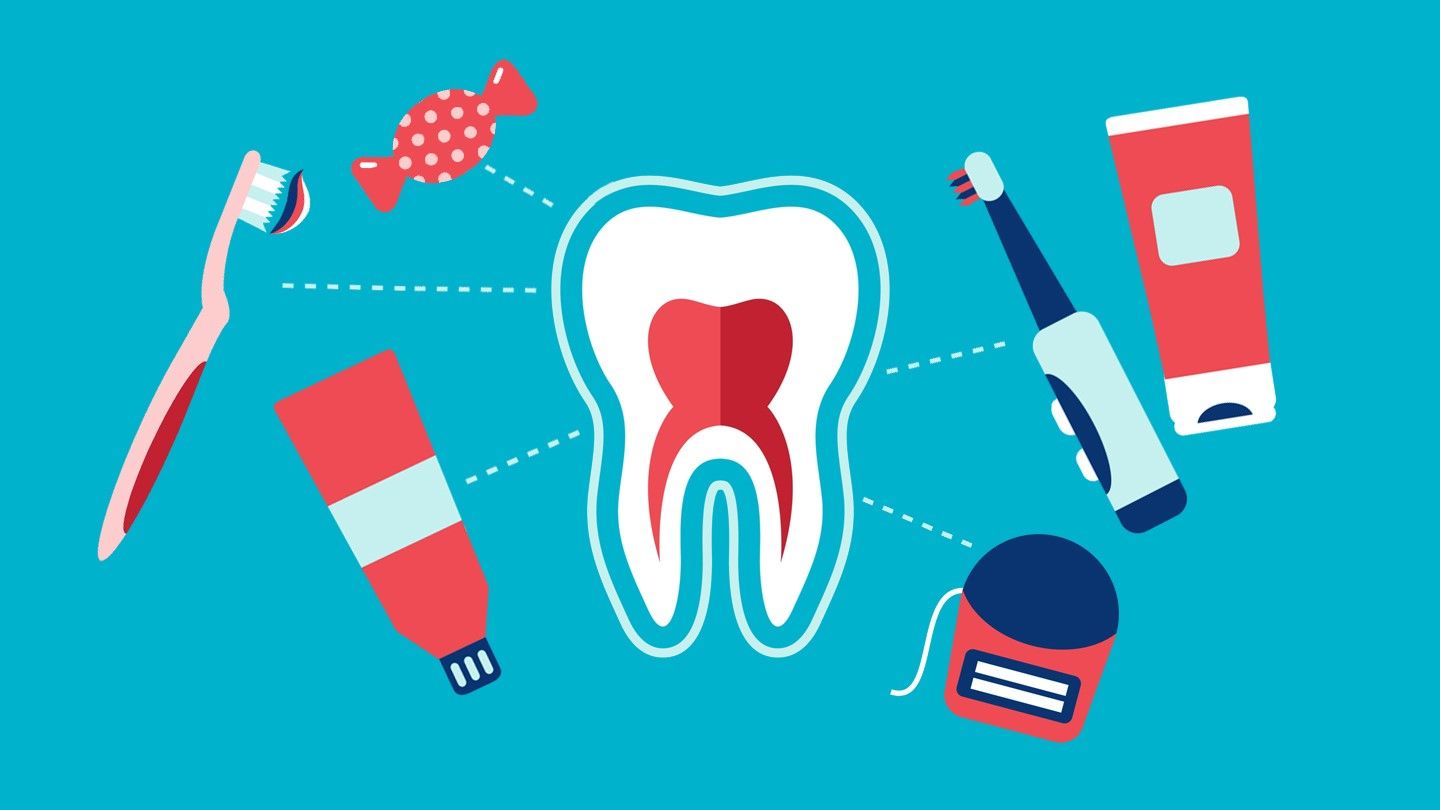 When did you last visit the dentist for a check-up and cleaning? Best practice dictates going every 6 months in order to avoid serious issues and to catch any concerns early on. Dental and oral health is one of the most important parts of your overall health and well-being. Poor oral hygiene can lead to dental cavities and gum disease and has been linked to heart disease, cancer, and diabetes. Maintaining healthy teeth and gums is a lifelong commitment.
When did you last visit the dentist for a check-up and cleaning? Best practice dictates going every 6 months in order to avoid serious issues and to catch any concerns early on. Dental and oral health is one of the most important parts of your overall health and well-being. Poor oral hygiene can lead to dental cavities and gum disease and has been linked to heart disease, cancer, and diabetes. Maintaining healthy teeth and gums is a lifelong commitment.
Even if you haven’t been to the dentist in quite some time, it is never too late to begin a regular routine to improve and maintain your oral health. If you’re not too keen on going to the dentist, that is understandable. However, it is not a reason to neglect your oral health. Ask around for a referral to a dentist that is highly regarded and ask questions about any concerns you have when you meet your dentist. Being open and honest about your oral hygiene and dental concerns with your dentists can prevent more serious issues from occurring down the road.
Here are the key components to easily maintaining your oral hygiene:
- Brush your teeth at least twice a day (Morning and Before Bed)
- Use fluoride toothpaste
- Brush your tongue
- Floss daily
- Limit your sugar intake
- Drink water
- Visit the Dentist every 6 months for a cleaning and general check-up
While not substitutes for regular brushing and flossing, using both mouthwash and chewing gum benefits oral health as well. On the other hand, behaviors like smoking and chewing tobacco can seriously impact oral health. Tobacco use comes with a myriad of negative oral health outcomes including discolored teeth, bad breath, gum disease, and cancer. For information on quitting tobacco use, visit www.quityes.org.
Choosing a good toothbrush and toothpaste is also part of the process. While there are countless products on the market, there is no need to overthink this. Generally, use soft bristle brushes to avoid damaging your teeth or gums and toothpaste with fluoride to help strengthen your enamel. From there you can explore variations to help control tartar, aid with sensitivity, or help with whitening. So long as both have the ADA seal of approval you will know you are using a product that has been properly tested. If you do feel overwhelmed, consult your dentist about your specific needs. Also, every 3-4 months you will want to toss out that used toothbrush and start using a fresh one.
Not sure if you have dental coverage under your current insurance plan? All students – regardless of whether or not they are enrolled in the Northwestern University Student Health Insurance Plan (NU-SHIP), may enroll in optional dental and/or vision coverage. Dental coverage helps you save money on dental procedures and allows for regular check-ups and cleanings.
Important Links/Resources
#Refreshed | The Importance of Quality Sleep
 As we turn back the clocks and the days get shorter, it seems like the perfect time to touch on the importance of sleep in our life. After all, time changes and seasonal affective disorder are two things that can impact sleep. Consistent quality sleep is one of the most important aspects of maintaining your overall health and wellbeing. Sleep is crucial to many bodily functions, especially our cognitive functioning. In fact, our brains actually clean themselves during sleep, helping maintain brain health and possibly preventing serious illness such as Alzheimer’s and other cognitive disorders. That’s how powerful good quality sleep is.
As we turn back the clocks and the days get shorter, it seems like the perfect time to touch on the importance of sleep in our life. After all, time changes and seasonal affective disorder are two things that can impact sleep. Consistent quality sleep is one of the most important aspects of maintaining your overall health and wellbeing. Sleep is crucial to many bodily functions, especially our cognitive functioning. In fact, our brains actually clean themselves during sleep, helping maintain brain health and possibly preventing serious illness such as Alzheimer’s and other cognitive disorders. That’s how powerful good quality sleep is.
Waking up still tired and feeling drowsy during the day is a clear sign that adequate sleep is not being obtained. As a student who is learning new things every day, sleep is essential to memory formation and retention. Being tired and not alert can impact your ability to retain and recall information, potentially impacting academic performance. Poor sleep is also linked to chronic health disorders including diabetes, cardiovascular disease, obesity, and depression.
Many things can affect our sleep both in the short and long term including numerous stressors to more severe issues like chronic insomnia and sleep apnea.
What does healthy/quality sleep look like?
- Getting 7-9 hours each night
- Falling asleep within ~20 minutes of laying down to sleep
- Remaining asleep; waking up no more than once per night
- Awaking feeling refreshed
The good news is, there are a lot of things you can do to improve your sleep and maintain quality.
- Maintain a consistent sleep schedule
- Limit caffeine and alcohol, especially close to bedtime
- Stay off of electronic devices close to bedtime
- Use blue light blocking glasses and apps that adjust the color settings in the evening
- Exercise
- Eat a healthy diet
- Keep the room cool but comfortable
- Declutter your sleeping space
- Use white noise to mask distracting sounds
- Try guided practices to help relax your body and mind
- Seek support and treatment for more serious conditions
Another option for addressing sleep disorders are sleep aids, but these should not be viewed as a replacement for good sleep habits or intended for long term use. While many sleep aids are considered ‘natural remedies’ you should still consult a physician before use especially if you are taking other medications in order to avoid any complications. Never take sleep aids with alcohol or other drugs.
There is a lot we know, yet still a lot we do not know about the intricacies of sleep. Explore the multitude of links that have been provided to dive deeper into the world of sleep and how you can work towards consistent quality sleep. If you would like to speak to somebody about improving your sleep, consider signing up for Wellness Coaching.
Important Links/Resources
#DitchJUUL | Understanding the Risks of Vaping and Nicotine Use
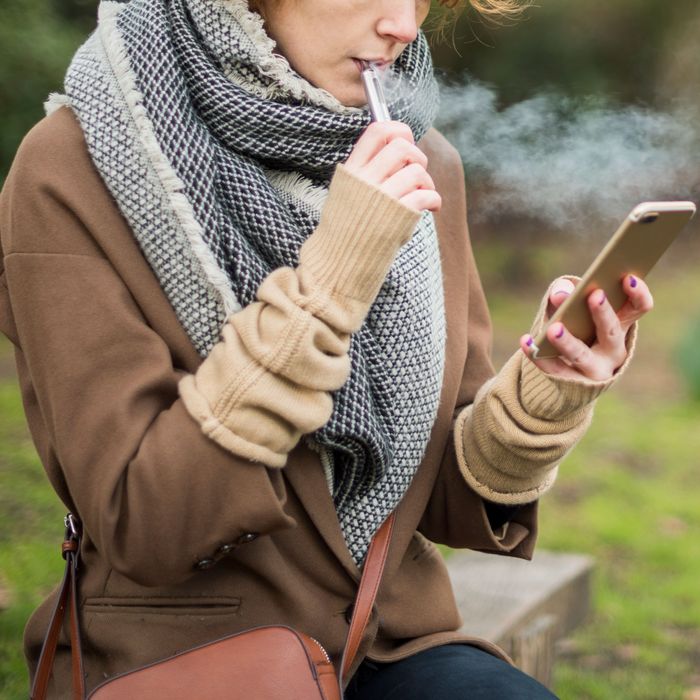 It is well known that smoking is among the leading causes of death annually contributing to adverse health conditions including cancer, heart disease, and respiratory diseases such as pneumonia, flu, and COPD. Now, with COVID-19 there is believed to be an increased risk associated with smoking and risk of severe illness. Major strides in public health efforts over the past few decades have been made and continue to be made to reduce the number of people who smoke. Recent legislation at the Federal, State, and local levels of government across the country have moved the legal age to purchase, possess and use tobacco products to 21 years of age. Changes like this help keep tobacco/nicotine products out of the hands of young people, reducing the chance of addiction from occurring, and ultimately, improving and prolonging people’s lives.
It is well known that smoking is among the leading causes of death annually contributing to adverse health conditions including cancer, heart disease, and respiratory diseases such as pneumonia, flu, and COPD. Now, with COVID-19 there is believed to be an increased risk associated with smoking and risk of severe illness. Major strides in public health efforts over the past few decades have been made and continue to be made to reduce the number of people who smoke. Recent legislation at the Federal, State, and local levels of government across the country have moved the legal age to purchase, possess and use tobacco products to 21 years of age. Changes like this help keep tobacco/nicotine products out of the hands of young people, reducing the chance of addiction from occurring, and ultimately, improving and prolonging people’s lives.
Unfortunately, much of the positive work to curb traditional cigarette smoking rates is being chipped away at due to the rise in vaping among youth. While some view vaping as a less harmful form of nicotine use or even as a way to stop smoking, much is still unknown on the effects vaping has on a person’s health. Chemicals contained in the aerosols produced by vaping are known to be carcinogenic. Vaping is NOT risk free and is not an FDA approved form of smoking cessation.
If you are currently using tobacco or nicotine products, including vapes, there are numerous resources to help you be free from nicotine. The first ever text-based vaping cessation resource launched this year called This is Quitting. Simply text DITCHJUUL to 88709 to begin receiving help today. Other free services to obtain tools, tips and resources to quit include the national tobacco Quitline at 1-800-QUIT-NOW and for Illinois residents, the Illinois Tobacco Quitline at 1-866-QUIT-YES.